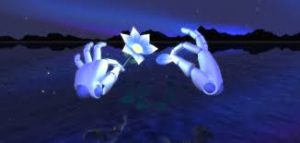My readings for this lesson revealed the following key ideas:
- The idea of coupling describes a mutually influential dynamic of interaction between learners and their environments. (Winn)
- The real power in augmented reality lies in using digital technology to enable students to see the world around them in new ways and to engage with realistic issues in a student-connected context. (Klopfer & Sheldon)
- If physical objects focus a child’s attention on irrelevant aspects of a procedure rather than on the underlying concept, the child may be unable to generalize learning to a new context. (Novack, Congdon, Hemani-Lopez, and Goldin-Meadow)
- A meta-analytical study of research articles by Wu, Wu, Chen, Kao, Lin, and Huang found that only 5% of the studied articles investigated the affective domain during mobile learning and only 5% evaluated the influence of learner characteristics in the mobile learning process.
As a math teacher who regularly recommends and models physical manipulative for math learning, I was initially saddened by Novack, Congdon, Hemani-Lopez, and Goldin-Meadow (2014) that action-based learning can actually inhibit students from applying their learning to novel contexts. Their further explanation, however, of the concreteness fading theory was reassuring as it pointed to the way in which I strive to use physical manipulatives. According to this theory, the most effective way to use representations for learning is to first introduce concrete representations then transition learners to more symbolic or abstract representations. Symbolic and abstract representation is where I envision a valuable role for augmented reality and mobile apps for learning. Students can progress from a concrete physical tool to a digitally represented tool, and ideally eventually to an abstract gesture approach that allows them to apply their learning in novel contexts without the limitations of technology availability. One way I envision using embodied learning with my senior math students is using body and arm positioning to represent the shape of particular types of functions, such as the trigonometric functions, a cubic, etc. By using movement to represent these forms, it is my hope that it will help them to apply the abstract rules to the physical position and movement. Following from Novack et al’s findings, having my students orally say certain conditions and rules while performing the gestures will potentially help them better internalize the learning.
Winn (2003) explains that internal rules or procedures that specify how a student interacts with his/her environment change through adaptation primarily based on their success at producing fruitful behaviour. Students working with physical manipulatives such as base-ten blocks will be able to use them fruitfully for particular contexts for a period of time. Eventually, they will reach a point where they are no longer applicable or efficient. Movement to a different method of exploration can thereby return the learning to fruitful levels. Eventually, the development of an abstract concept will likely enable the student to use abstract strategies to produce fruitful behaviour that was not possible with other tools. For my own STEM practice, this reinforces the idea of scaffolding learning experiences to move students from the concrete to the abstract in progressive stages that allow them to also recognize limitations and learning needs for themselves. With the growth of mobile learning opportunities and device proliferation, this process can be further expanded into the home as students are able to engage in representative learning activities on personal devices as well. Wu et al (2012) highlight the conclusion of Ketamo (2003) that while mobile technology can generally bring some added value to network-based learning, it cannot replace conventional computers. As mobile devices continue to advance in their development they offer more possibilities, but there remain tasks that are far better suited to a computer, such as those that require large amounts of memory, processing power, electrical power, or certain forms of tactile interaction such as a full-size keyboard. Thus, I still recognize connected but different roles for both mobile technologies and computer-based technologies as components of the learning process.
Questions Arising:
If educational philosophy is increasingly focusing on student engagement through personal connection and the affective component of holistic development, how can we reconcile a push for these personalized approaches with a seeming lack of sufficient research on the affective and learner-centered influence of mobile learning opportunities?
Winn explains Umwelt as the environment as seen and understood by different individuals. Recognizing that understanding a student’s Umwelt is essential to engaging them in meaningful and fruitful learning opportunities, what are strategies a teacher can use to gain a deeper understanding of a student’s Umwelt in any given situation, particularly when a student is currently lacking in engagement?
Novack et al found that gesture was an important component of grade 3 students learning how to group when adding more than two numbers as they used their hand to gesture the v-formation of combining values. How can gesture be incorporated into the teaching of more complex mathematical processes?
Resources:
Klopfer, E., & Sheldon, J. (2010). Augmenting your own reality: Student authoring of science‐based augmented reality games. New directions for youth development, 2010(128), 85-94.
Novack, M. A., Congdon, E. L., Hemani-Lopez, N., & Goldin-Meadow, S. (2014). From action to abstraction: Using the hands to learn math. Psychological Science, 25(4), 903-910.
Winn, W. (2003). Learning in artificial environments: Embodiment, embeddedness, and dynamic adaptation. Technology, Instruction, Cognition and Learning, 1(1), 87-114.
Wu, W. H., Jim Wu, Y. C., Chen, C. Y., Kao, H. Y., Lin, C. H., & Huang, S. H. (2012). Review of trends from mobile learning studies: A meta-analysis. Computers & Education, 59(2), 817-827.

